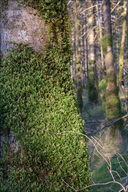|
|
click photo for larger file

Exsertotheca crispa
Crisped Neckera
|
Photographer: Dr. Amadej Trnkoczy
ID: 0000 0000 0223 0339 (2023-02-08)Copyright © 2023 Dr. Amadej Trnkoczy
|
|
INFORMATION PROVIDED WITH THE PHOTO
|
date of photo Feb 27, 2022
latitude 46.35926 longitude 13.70633
View on Google Maps.
location
Lower Trenta valley, between villages Soča and Trenta, east most part of a small riparian forest on the right bank of river Soča situated south of Otokar farmhouse, Trenta 4; East Julian Alps (Posočje, Slovenia)family
Neckeraceae
notes Slo.: zgrbljeni zavesar - syn.: Neckera crispa Hedw., Neckera pseudopennata (Warnst.) Scjlieph. & Zmuda. - Habitat: riparian forest on young alluvial deposits, flat terrain; calcareous, alluvial ground; predominantly Picea abies, some Fagus sylvatica and Salix eleagnos; in shade, high ground and air humidity; partly protected from direct precipitations by tree canopies; average precipitations ~ 3.000 mm/year, average temperature 6-8 deg C, elevations 535 m (1.760 feet), alpine phytogeographical region (M. Wraber, 1969). - Substratum: bark of Picea abies and other trees. - Comments (pertains to pictures in the Flicker album Exsertotheca crispa): Exsertotheca crispa is a pleurocarpous moss. That means that capsules are borne on short, lateral branches. Therefore, they emerge mid stem and not at the tips of stems or branches as with acrocarpous mosses. The species is large; the longest shots can be well over 10 cm long. Capsules are relatively rare (see Fig. 22b for some). Distinctive traits of the species are glossy (whether moist or dry!) and strongly, transversely undulated leaves and wide, distinctly flattened shots. They offer a strikingly handsome look, particularly under an appropriate angle of in falling light. - Generally, the main substratum according to literature are calcareous rocks and boulders and, much less common, bark of the trunk base of trees. In rare occasions it can be found also on ground. Yet, in the Trenta valley this is different. Finds on rocks (although nearly all rocks and boulders in the region are calcareous) are relatively rare compared to extensive occurrences of Exsertotheca crispa on tree bark in the small patches of riparian forest along the river Soča. In these very humid places Exsertotheca crispa grows on lower parts of living and dead Picea abies (which are the dominant species in this habitat) and other trees. The trunks are often thickly covered by this moss from ground to sometimes well over 2 m height. - The pictures in this album show Exsertotheca crispa on three substrates: on forest ground (Figs: 1 - 3.), on dry stone fence (Figs: 10 - 13.) and on tree bark (Figs: 20 - 24.). - Ref.: (1) M. Nebel, G. Philippi, eds., Die Mosse Baden-Wurttembergs, Band 2., (2001), Ulmer, p 230. (2) M. Lüth, Mosses of Europe – A Photographic Flora, Michael Lüth, Vol. 3., 2019, pp 1302. (3) Ian Atherton, Ed., Mosses and Liverworts of Britain and Ireland - a field guide, British Bryological Society (2010), p 680. (4) https://www.britishbryologicalsociety.org.uk/learning/species-finder/neckera-crispa/ (accessed Feb. 05. 2023)camera Sony ILCE6000 / Carl Zeiss Vario-Tessar E 16-70 mm/f4
contributor's ID # Bot_1438/2022_00867 photo category: Plant - mosses/etc
|
MORE INFORMATION ABOUT THIS PLANT
|
| common names
Crisped Neckera (photographer)
View all photos in CalPhotos of Exsertotheca crispa Check Google Images for Exsertotheca crispa |
|
The photographer's identification Exsertotheca crispa has not been reviewed. Click here to review or comment on the identification. |
|
Using this photo The thumbnail photo (128x192 pixels) on this page may be freely used for personal or academic purposes without prior permission under the Fair Use provisions of US copyright law as long as the photo is clearly credited with © 2023 Dr. Amadej Trnkoczy.
For other uses, or if you have questions, contact Dr. Amadej Trnkoczy amadej.trnkoczy[AT]siol.net. (Replace the [AT] with the @ symbol before sending an email.) |
|
|
